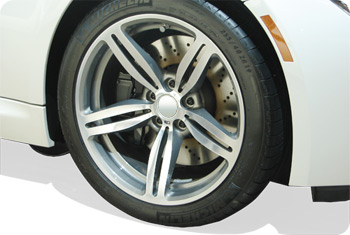When reading about or shopping for brake rotors or pads, you probably have come across people talking about "bedding-in" their brakes. What does that mean, and why should you do it?
Bedding your brake pads and rotors is essential if you want your brakes system to work optimally. Simply put, the bed-in process (aka break-in, conditioning, or burnishing) deposits an even layer of material from the brake pad onto the friction surface of the disc rotor. This layer, known as a transfer layer, enhances the friction-generating properties of your pads and rotors, improving your brakes' performance and extending their lifespan.
Here's a note from Power Slot/StopTech about breaking in your brakes:
It is very important that you bed your brakes carefully and precisely. The key to bedding is that the transfer layer must be completely even; even a few thousandths of an inch of width variation across the rotors can cause vibration and judder, severely compromising your braking performance and driving comfort.
How To Break In Your Brakes
Here are the basic steps on how to bed your brakes:
- The bedding-in process requires lots of accelerating and quick decelerating. Perform this process early in the morning and in a low-traffic area so that you avoid other vehicles.
- From 60 MPH, apply the brakes gently a few times to bring them up to their usual operating temperature. This prepares your pads and rotors for the high heat generated in the next steps.
- Make a near-stop from 60 to about 10 MPH. Press the brakes firmly, but not so hard that the ABS engages or the wheels lock. Once you've slowed down, immediately speed up to 60 MPH and apply the brakes again. Perform this cycle 8-10 times. Do not come to a complete stop! If you hold the brake pedal down while stopped you will leave excessive pad material on the rotors and ruin your braking performance.
- Once you've performed that final near-stop, accelerate and drive a bit more, trying to use the brakes as little as possible so they can cool down. Again, do not come to a complete stop while the brakes are still hot. (Avoid traffic!)
- If you are bedding in performance/racing brakes, you may have to perform extra near-stops from a higher speed.
Some more notes about bedding:
- Brand new brake pads and rotors will have very little braking power on their first few applications. Gently apply your brakes from low speeds a few times to establish some grip before you take your vehicle onto the highway or busy roads.
- Don't immediately bed your brakes if you have brand new rotors with phosphate, cadmium, or zinc plating. Do some normal driving to polish the plating off the rotors before bedding in your brakes.
- After you perform the break-in cycle you should see a light gray film and a slight blue tint on the rotor face. The gray film is material from the pads transferring onto the rotor face, and the blue tint indicates that the rotor has reached the proper break-in temperature. These are good signs that you have bedded your brakes properly.
- Some brakes, such as big brake kits or new pads installed onto old rotors, may require a second bed-in cycle. Let the brakes cool down fully before performing the second cycle.
Conclusion
Bedding your brakes is an important process to ensure maximum braking performance, safety, and comfort. If you have any more questions about brake conditioning or maintenance, feel free to call our experienced Customer Service staff at 800-663-1570.




